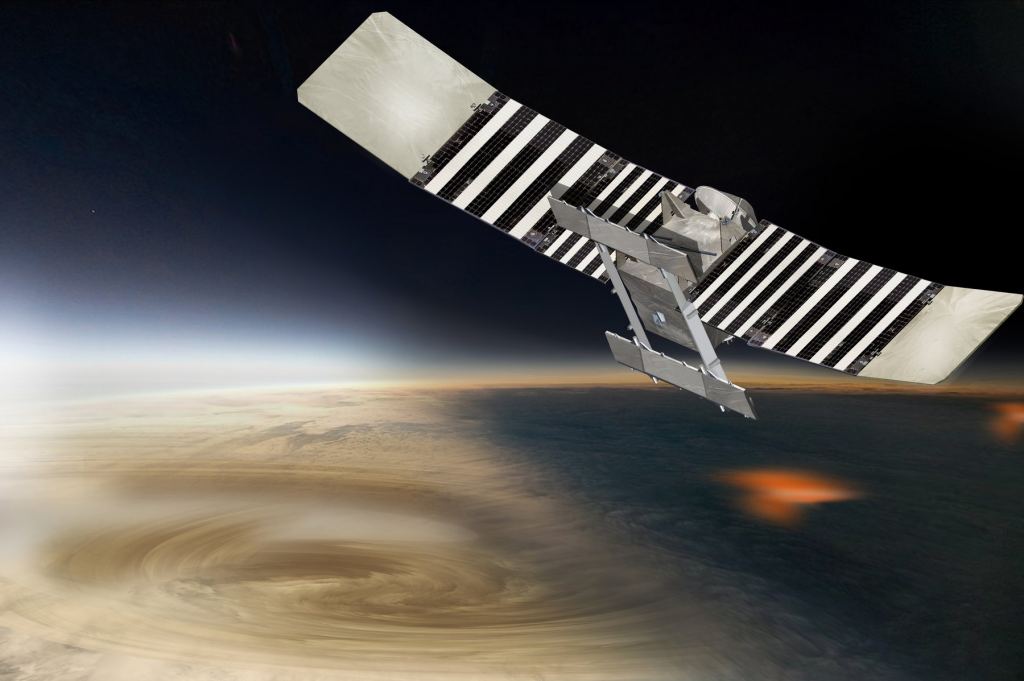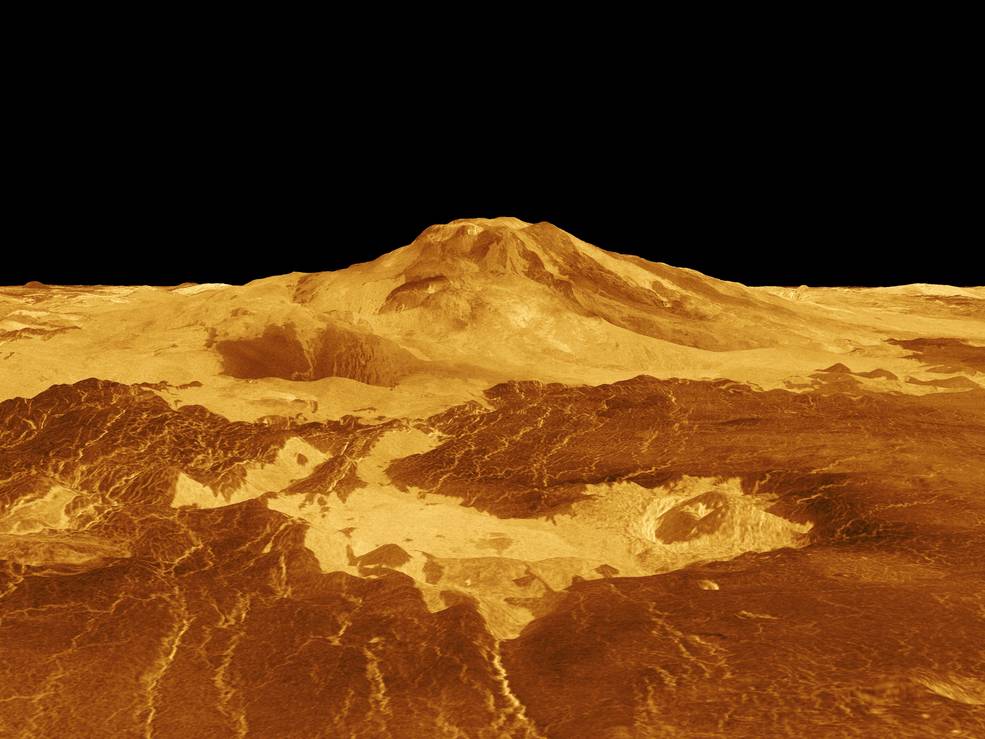Is there anything good about volcanoes? They can be violent, dangerous, and unpredictable. For modern humans, volcanoes are mostly an inconvenience, sometimes an intriguing visual display, and occasionally deadly.
But when there’s enough of them, and when they’re powerful and prolonged, they can kill the planet that hosts them.
Modern-day Venus is a blistering hellscape. The temperature rises above 464 C (850 F, 737 K), which is, as Universe Today readers know, hot enough to melt lead (and spacecraft). It’s why, out of all the missions Russia sent to the planet’s surface, only four managed to transmit pictures before quickly succumbing to Venus’ extreme conditions.
But modern-day Venus might be dramatically different from ancient Venus. Some research shows that ancient Venus had an atmosphere similar to ancient Earth’s. The planet may also have had substantial quantities of water on its surface. It’s possible that simple life existed on Venus at one time, but there’s not enough evidence yet to prove or disprove that.
A new study shows that massive volcanic eruptions over an extended period of time may be responsible for changing the planet into what it is today. If there was simple life on ancient Venus, volcanism was its doom. The study also shows how powerful volcanic activity has played a role in shaping Earth’s habitability and how Earth only narrowly avoided the same fate as Venus.
The study is titled “Large-scale Volcanism and the Heat Death of Terrestrial Worlds,” and it’s published in The Planetary Journal. Dr. Michael J. Way of NASA’s Goddard Institute is the lead author. Way has been researching Venus for years and is the author and co-author of several papers on the planet, especially its ancient habitability. “By understanding the record of large igneous provinces on Earth and Venus, we can determine if these events may have caused Venus’ present condition,” Way said in a press release announcing the study.

Earth has experienced prolonged periods of sustained volcanic eruptions in its history. Large Igneous Provinces (LIPs) are the evidence for the periods, which can last hundreds of thousands of years—maybe even millions of years. LIPs can deposit more than 100,000 cubic miles of rock on the surface. That’s enough to bury Texas a half-mile deep. On Earth, we know of many LIPs, and we know that in the last 500 million years, they coincide with periods of climate change and with mass extinctions.

The study suggests that Venus underwent massive volcanic outbursts of its own that created Venus’ modern atmosphere, with its extreme temperatures and pressures. More specifically, it says that intense outbursts in a period as short as one million years created a runaway greenhouse effect. The runaway greenhouse effect is when an atmosphere prevents a planet’s heat from radiating into space. With no way to cool, the temperature rises to extreme levels, like a greenhouse with all its vents closed.
Venus’s greenhouse effect is exacerbated by its apparent lack of plate tectonics. Earth’s plate tectonics allows heat from the planet’s interior to reach the surface by periodically opening the mantle blanket. It also takes carbon dioxide out of the atmosphere and into rock via weathering and subduction.
Our planet’s experienced five mass extinctions, and all of them are associated with increased volcanic activity, according to this work. (Some researchers point to a sixth mass extinction that is just beginning, as human activity causes increased species loss.) The Chicxulub impact event was the prime driver of the Permian-Triassic extinction that wiped out the dinosaurs, but volcanic activity also played a role. While the Chicxulub dinosaur extinction is well-known and popularized dramatically, volcanic activity has been the principal driver of extinctions on Earth.

Life on Earth suffered mightily from powerful and sustained volcanic activity. But it always recovered, and the volcanoes never caused a runaway greenhouse effect, while Venus suffers to this day from the effect. What’s the difference?
The scale of eruptions had something to do with it. Venus’s surface is 80% covered with solidified volcanic rock. The sulphur in the atmosphere is also evidence of pronounced volcanic activity. And Venus’ surface has fewer craters than expected, indicating abundant volcanic activity in the last few hundred million years.
But the study should make anyone uncomfortable. Though Earth has avoided the runaway greenhouse effect, it may only have narrowly avoided it.
Untangling the history of volcanism, impacts, and extinctions in Earth’s history is challenging because craters get erased. There are scientific efforts to understand the conditions in Earth’s mantle that lead to LIPs, but that’s also a difficult task.
The magmatic events that create LIPs are typically short-lived in geological time scale, less than 5 million years in duration. They can also be a series of pulses over a few tens of millions of years. Though they push a lot of rock onto the surface, the chemicals they emit into the atmosphere are what drive extinctions. Massive quantities of CO2 heated Earth’s atmosphere dramatically, and sulphur dioxide (S02) compounded the warming. Toxic compounds like hydrogen sulphide (H2S) and carbon monoxide (CO) also come from eruptions, but only in tiny amounts.
Earth’s volcanic activity is similar to Venus’ because the planets are “sister planets.” They’re very close in size and are both rocky planets in the inner Solar System. But the critical thing they share when it comes to volcanism is their bulk composition. Since they formed in the same region of the Solar System, they have very similar compositions.

In their study, the authors recreated Earth’s volcanic history in random simulations based on what’s known about Earth’s volcanic activity and LIPs. “In one approach, we make a conservative estimate of the rate at which sets of near-simultaneous LIPs (pairs, triplets, and quartets) occur in a random history statistically the same as Earth’s,” the authors write. “We find that LIPs closer in time than 0.1–1 million yr are likely; significantly, this is less than the time over which terrestrial LIP environmental effects are known to persist.”
That means that LIP events overlap one another, and before the planet can remove the CO2 released into its atmosphere from one event, another is busy releasing more. String enough of those together, and you get the runaway greenhouse effect. Separate LIPs on different parts of the globe, even under the oceans, exacerbate the effect.

A key part of their study concerns variability. Are LIPs related to one another causally? That matters because if the LIP rate is variable, then that increases the likelihood of overlapping or simultaneous events, which would contribute to a runaway greenhouse effect.
“How would variability in the LIP rate over time affect the chances for simultaneous events?” the authors write. “During times of increased rate, the probability of simultaneous events is enhanced over that for the average rate. On the other hand, during times of decreased rate, this probability is diminished relative to the average. It is not obvious which of these effects predominates.”
An interesting point in all of this concerns Earth’s longest-lasting LIPs. The longer one lasts, the more likelihood there is of it overlapping with another. “… we find that the probability of the largest LIP in recorded Earth history overlapping with a similar-sized (in area) event is approximately 30%. Multiple simultaneous LIPs may be important drivers of the transition from a serene habitable surface to a hothouse state for terrestrial worlds, assuming they have Earth-like geochemistries and mantle convection dynamics,” the paper states.
There’s a point where all of this diverges. While we have fairly complete and reliable data on Earth’s LIPs, we don’t have anywhere near that for Venus. But the research shows that, even with our lack of detailed data, it’s likely that Venus suffered overlapping LIPs that led to its doom.
Fortunately, upcoming missions to Venus will open this inquiry up with better data.
The Venus VERITAS (Venus Emissivity, Radio Science, InSAR, Topography, and Spectroscopy) mission is an orbiter being developed by NASA. Its launch date isn’t yet scheduled, but it’ll be a three-year mission to image Venus’ surface in high resolution using radar and near-infrared spectroscopy. It’ll provide detailed information on the planet’s impact history, volcanism, geochemistry, and more.

The DAVINCI (Deep Atmosphere Venus Investigation of Noble gases, Chemistry, and Imaging) mission is also a NASA mission, but it’ll have an atmospheric probe along with an orbiter. Once scientists have more detailed information on Venus’ atmosphere and its surface, they can start untangling the planet’s past. “A primary goal of DAVINCI is to narrow down the history of water on Venus and when it may have disappeared, providing more insight into how Venus’ climate has changed over time,” Way said.

Both DAVINCI and VERITAS will launch in the late 2020s, with DAVINCI launching first.
The ESA is planning an orbiter mission to Venus, too. It’s called EnVision and should launch in the early 2030s. EnVision will also study Venus’s atmosphere, but it’ll dig deeper, using its instrument package to investigate the planet’s internal structure.
These results will also play a role in understanding exoplanets. Exoplanets are a burgeoning area of research, and the James Webb Space Telescope is beginning to deliver better data on exoplanet atmospheres. But it’ll be difficult for scientists to interpret the JWST’s findings without better overall models, and a more detailed understanding of our sister planet’s history will definitely refine our models for planetary atmospheres.
For some reason, Earth has remained habitable for billions of years, and Venus is much worse off. If Venus ever hosted ancient, simple life, it’s long gone now. (Apologies to people who think life might live on in Venus’ clouds.) While we may never have a complete understanding of all the factors that made Earth and Venus so different from one another, volcanic activity clearly played a role. Once VERITAS, DAVINCI, and EnVision do their thing, we should understand Venus’ divergent path in more detail.


Without better record of Venus history it is hard to tell if this made any difference, even granted that Venus had less of a plate tectonics turnover process. A relatively recent massive volcanism makes it even harder to tell if it is peculiar to Venus stagnant lid history.
“Our planet’s experienced five mass extinctions, and all of them are associated with increased volcanic activity, according to this work. (Some researchers point to a sixth mass extinction that is just beginning, as human activity causes increased species loss.)”
There has been a long history of trying to add and subtract mass extinctions, but the 5 Big Extinctions are fairly established. Therefore it was surprising to see how neatly the new pre-Cambrian Ediacaran mass extinction hypothesis slotted in to explain the earlier mysterious succession of assemblages – the Avalon (ca. 575–560 Ma), White Sea (ca. 560–550 Ma), and Nama (ca. 550–539 Ma) and the Cambrian “explosion” – and their ecology [“Environmental drivers of the first major animal extinction across the Ediacaran White Sea-Nama transition”, Evans et al., PNAS 2022]. The anoxic ocean – earlier established by geologists – had hit the White Sea quite hard, and at Nama the diversity had dropped by 80 % with the ecology driven towards modern morphology and behavior – e.g. animals that moved had weathered the changes better.
Add the putative prokaryote mass extinction that seems to have happen, with a massive culling of an estimated 99 % of lineages, at the oxygenation of the atmosphere and Earth may soon have seen at least 8 mass extinction events.